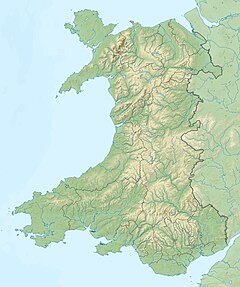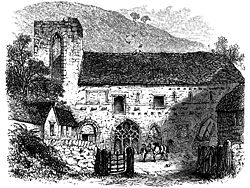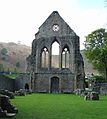
Llangollen is a town and community, situated on the River Dee, in Denbighshire, Wales. Its riverside location forms the edge of the Berwyn range, and the Dee Valley section of the Clwydian Range and Dee Valley Area of Outstanding Natural Beauty, with the easternmost point of the Dee Valley Way being within the town. It had a population of 3,658 at the 2011 census.

Until 1974, Denbighshire, or the County of Denbigh, was an administrative county in the north of Wales, later classed as one of the thirteen historic counties of Wales. It was a maritime county, that was bounded to the north by the Irish Sea, to the east by Flintshire, Cheshire and Shropshire, to the south by Montgomeryshire and Merionethshire, and to the west by Caernarfonshire.

Castell Dinas Brân is a medieval castle, built by the Princes of Powys Fadog, which occupies a prominent hilltop site above the town of Llangollen in Denbighshire, Wales. The presently visible stone castle was probably built in the 1260s by Gruffydd Maelor II, a prince of Powys Fadog, on the site of several earlier structures, including an Iron Age hillfort.
Abbeycwmhir or Abbey Cwmhir is a village and community in the valley of the Nant Clywedog in Radnorshire, Powys, Wales. The community includes the hamlet of Bwlch-y-sarnau.

Cymer Abbey is a ruined Cistercian abbey near the village of Llanelltyd, just north of Dolgellau, Gwynedd, in north-west Wales, United Kingdom.
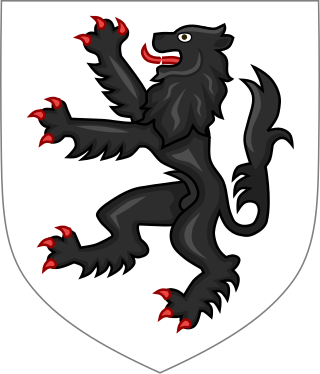
Madog ap Gruffudd, or Madog ap Gruffudd Maelor, was Prince of Powys Fadog from 1191 to 1236 in north-east Wales, and Lord of Powys. He was the founder of Valle Crucis Abbey in the lordship of Yale.
Gruffydd Maelor II was Prince of Powys Fadog.
Madog II was a Prince of Powys Fadog from 1269 to 1277.
Madog Crypl, also known as Madog ap Gruffydd Fychan was a descendant of the sovereign Princes of Powys Fadog and Lords of Dinas Bran. He is sometimes described as Madog III of Powys Fadog. However, he was only lord of some of the family lands under the English crown.
Madog Fychan was a member of the family of Princes of Powys Fadog, though he never gained the title, being brother of Gruffydd Maelor II. He was an ally to Dafydd ap Llywelyn in his campaign to attack English possessions in Wales in 1245 and sided with Llywelyn ap Gruffydd in 1258 in his claim to the title of Prince of Wales. He died in December 1269.
Guto'r Glyn was a Welsh language poet and soldier of the era of the Beirdd yr Uchelwyr or Cywyddwyr ("cywydd-men"), the itinerant professional poets of the later Middle Ages. He is considered one of the greatest exponents, if not the greatest, of the tradition of "praise-poetry", verse addressed to a noble patron.
Maredudd ap Rhys, also spelt Meredudd ap Rhys, was a Welsh language poet and priest from Powys. He was born in gentry, having pedigree blood, as discovered from the Peniarth Manuscripts. He is thought to have been the bardic tutor to Dafydd ab Edmwnd, and thus won distinction both as a poet and as a poetry teacher.

Cwmhir Abbey, near Llandrindod Wells in Powys, is a Welsh Cistercian monastery founded in 1176 by Cadwallon ap Madog. A spurious tale was later recorded that the abbey was founded in 1143 by Meredudd ap Maelgwn at Ty-faenor, and then refounded at the present location near the village of Abbeycwmhir in 1176. There does appear to be a site movement from Ty-faenor, but Maredudd ap Maelgwn was prince of Maelienydd in 1215 under Prince Llywelyn ab Iorwerth of Gwynedd, who then controlled the district. The later charter to the abbey in 1215 caused the confusion and led to the belief that Maredudd had founded the abbey in 1143.

The Abbey of Strata Marcella was a medieval Cistercian monastery situated at Ystrad Marchell on the west bank of the River Severn near Welshpool, Powys, Wales.
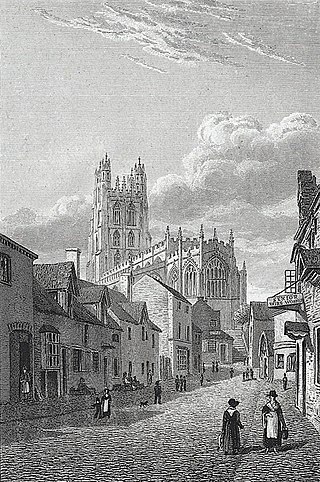
The city of Wrexham in north-east Wales has a history dating back to ancient times. The former market town was the site of heavy industry in the 19th and 20th centuries, and is now an active commercial centre. Wrexham was granted city status in 2022.

Ial or Yale was a commote of medieval Wales within the cantref of Maelor in the Kingdom of Powys. When the Kingdom was divided in 1160, Maelor became part of the Princely realm of Powys Fadog, and belonged to the Royal House of Mathrafal. Yale eventually merged with another commote and became the Lordship of Bromfield and Yale, later a royal lordship under the Tudors and Stuarts.

The Royal House of Mathrafal began as a cadet branch of the Welsh Royal House of Dinefwr, taking their name from Mathrafal Castle. They effectively replaced the House of Gwertherion, who had been ruling the Kingdom of Powys since late Roman Britain, through the politically advantageous marriage of an ancestor, Merfyn the Oppressor. King Bleddyn ap Cynfyn would join the resistance of the Anglo-Saxon King Harold Godwinson, against the invasion of William the Conqueror, following the Norman conquest of England. Thereafter, they would struggle with the Plantagenets and the remaining Welsh Royal houses for the control of Wales. Although their fortunes rose and fell over the generations, they are primarily remembered as Kings of Powys and last native Prince of Wales.

Bryneglwys is a village and community in Denbighshire, Wales. The village lies to the northeast of Corwen on a hill above a small river, Afon Morwynion, and is situated in the ancient commote of Iâl (Yale). The community covers an area of 9.45 square miles (24.5 km2) and extends to the top of Llantysilio Mountain. It had a population of 369 at the time of the 2011 census, an increase from 344 during the 2001 census.
Gweirca ferch Owain was a medieval Welsh noblewoman, granddaughter of Madog ap Gruffydd Maelor and daughter of Owain ap Gruffydd ap Madog.
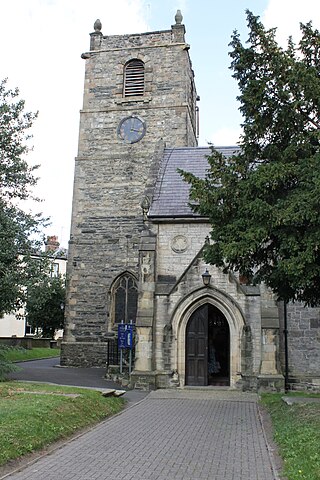
St Collen's Church is a parish church in the town of Llangollen, Denbighshire, Wales. The first church on the site was founded by Collen in the 6th century. Nothing of this building remains. A new church was built in the 13th century, in the Early English Gothic style. This was developed in the succeeding centuries, and then almost completely rebuilt in the 19th century. The architect of the Victorian reconstruction was Samuel Pountney Smith, who retained little of the earlier church, with the exception of the tower. The churchyard contains the grave of the Ladies of Llangollen, Eleanor Charlotte Butler and Sarah Ponsonby, and their servant Mary Carryl, who lived at the nearby Plas Newydd. In November 2021 the first blessing of a gay partnership in a Church in Wales church was held at St Collen's. The church is an active parish church in the Diocese of St Asaph. It is designated by Cadw as a Grade I listed building.

